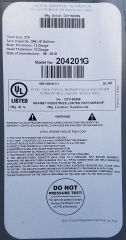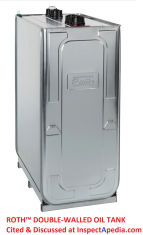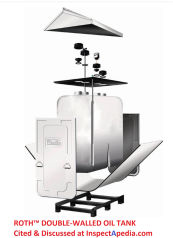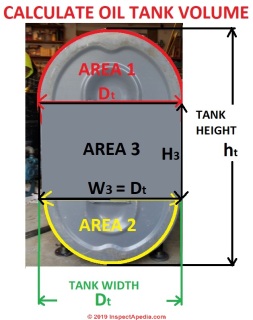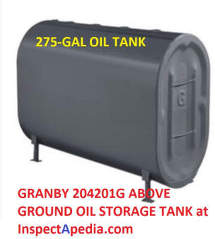 Heating Oil Storage Tank Size
Heating Oil Storage Tank Size
Standard, Measured & Calculated oil tank sizes
- POST a QUESTION or COMMENT about oil tanks: ASTs, USTs and how to figure out the capacity of an oil tank
Heating oil storage tank capacity: how to find out how much oil your above ground or underground oil tank can hold.
This oil tank information article series answers nearly all questions about above ground or buried oil storage tanks including oil tank inspection & testing, oil tank abandonment or removal, removal, oil storage tank & tank piping leak testing, leak prevention, and oil storage tank regulations.
InspectAPedia tolerates no conflicts of interest. We have no relationship with advertisers, products, or services discussed at this website.
- Daniel Friedman, Publisher/Editor/Author - See WHO ARE WE?
Oil Storage Tank Volumes, Standard Sizes, Size Calculation
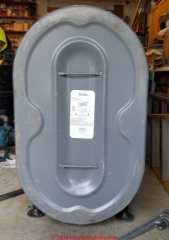 Here we explain how to figure out or find out how much oil your storage tank can hold. What is the oil tank nominal size, rated size, or actual working capacity or volume in US gallons or in Imperial gallons.
Here we explain how to figure out or find out how much oil your storage tank can hold. What is the oil tank nominal size, rated size, or actual working capacity or volume in US gallons or in Imperial gallons.
Click to enlarge any image]
How to Determine Oil Storage Tank Size
Shown above: photo of the ovate end of a single-wall 12-gauge steel Granby™ Model No. 204201G 275 gallon above ground oil storage tank during installation in a New York home.
[Click to enlarge any image]
This tank is labeled as UL-Listed (UL-80), thus in compliance with UL 80 Standard for Steel Tanks for Oil-Burner Fuels and Other Combustible Liquids. UL-80 excerpt giving scope of this standard:
These requirements cover steel primary, steel secondary, and steel diked type atmospheric storage tanks from 60 to 660 gallons (227 to 2500 L) intended primarily for the storage and supply of heating fuels for oil burning equipment, or alternately for the storage of diesel fuels for compression ignition engines and motor oils (new and used) for automotive service stations, in aboveground applications.
Sorting through "how big is this oil tank" we note that this tank is labeled as
- Tank Size: 275 gallons
- Tank Capacity: 266 gallons
Because this residential oil storage tank was being installed at a site where more than 1,320 U.S. gallons of aggregate oil storage capacity is present, an additional label affixed to the tank by the installer notes that the tank has a
- Working Capacity: 247 gallons
Question: How can I tell how many gallons an unmarked oil tank holds ?
2019/12/20 James E. McGrail said:
How can I tell how many gallons an unmarked oil tank holds ?
There are two numbers on the one in question on the Underwriters Lab. plate --- as follows: P 963220 and MH-15475-1 .
It also says "inside tank for oil burner fuel . I can be answered via "E" mail at maccountry2264@yahoo.com I appreciate your help .
Mac McGrail
Reply: measuring & other means: oil storage tank size determination
I don't think the UL numbers will give the tank size.
There are several approaches to making a reasonable guess at the oil tank capacity when you cannot see an actual size label on the tank:
1. Get the size of un-known buried oil tanks: call the oil delivery company to review their delivery history and find the largest volume; the tank will probably be a standard size number just a bit larger than that.
Residential buried oil tanks are usually 500, 550, 750, 1000 or 1,500 gallons or occasionally larger. In rare cases some idiot buries an above-ground-use tank that might be 250 or 275 gallons.
Roth double-walled oil storage tanks are rectangular in shape and are available in sizes as low as 110 gallons.
A 110-gallon Roth double-walled AST(shown above) measures 29" long x 28" wide x 44" high.
Buried oil tank shapes include round, "oval" (not a true oval), rectangular, and even spherical like this photo contributed by David Grudzinski, Advantage Home Inspections, in Rhode Island.
2. To get the size of above ground storage tanks, if there is a label visible on your oil tank it may give you the nominal, rated, and working oil tank size or capacity. The photo above on a Granby oil storage tank shows that the tank's nominal size is 275 gallons. The actual working volume of heating oil that can be stored in the tank will normally be a smaller number.
If there are no tank labels or markings giving its size, look at the tank and measure it. A typical above ground OLDER oil storage tank is somewhat-oval in cross section and is usually 250g or 275g.
However the range of above ground residential oil tank sizes includes some irregular numbers in gallons besides 250 & 275 gallons, including 288 gallons, 340 gallons, 420 gallons, 518 gallons, 550 gallons, 555 gallons and 675 gallons.
In a typical older 275 g tank installation when measuring the tank note that the legs will be supporting the tank some distance above the floor or ground level.
Example:
- Bottom of tank is 4" above the floor slab (9-inch legs).
- Top of tank is 48 3/4" above the floor slab.
So the tank height is nominally 44".
Nominal 275 gallon Oil Tank DImensions
- The tank itself is about 44" tall.
- The tank length is 60"
- The tank width measured at its center (not in the rounded top or bottom areas) is 27"
Watch out: in modern oil tank labeling you'll see that the tank is not intended to be filled to it's very top or out into the filler pipe (over-filling risks damage or leaks); So a nominal 275-gallon tank may be marked as "Maximum Fill 247 gallons".
Typical 330 Gallon Oil Tank Dimensions
- Ht - The tank itself is about 44" tall.
- Lt - The tank length is 72"
- Wt- The tank width measured at its center (not in the rounded top or bottom areas) is 27"
Calculate oil tank volume
Look again at our oil tank photos just above where you will see where we measure
- oil tank width Wt = Dt since we will use the width for both the width of the retangular portion of the tank AND for the diameter of the cylinder formed by the tank's rounded top and bottom sections
- oil tank height ht, and in the second photo
- oil tank length Lt
Calculate the oil tank volume or size in these steps:
- Measure the oil tank width, height, and length.
Measure the oil tank width Wt or Dt - as shown above: our example tank width is 27"
Measure the oil tank height or ht - our example oil tank height is 44"
Measure the oil tank length or Lt - our example oil tank length is 60" (hint, this is a nominal 275 gallon tank so we'll be able to perform a "sanity check" on our math.
Divide the area of the end of the oil tank into a center rectangle and two half-circles that form the rounded oil tank top and oil tank bottom. If your oil tank curves are pretty much "round" then our arithematic will be easy.
The diameter of the circle is identical to the oil tank width, Dt. The volume of the curved areas of the tank (top and bottom added together) forms a cylinder of diameter Dt and length Lt.
- Calculate the volume of the rounded areas of the tank top and bottom by treating these as a cylinder.
The volume of a cylinder V = pi x r2 x h
where π or pi = 3.1416
r = cylinder radius (1/2 the diameter) (this is going to be 1/2 our oil tank diamete or 0.5 x Dt)
h = the cylinder height or length of pipe in our case (this is our oil tank length Lt)
V or G = the volume of oil in U.S. gallons = (Number of cubic inches x 0.004329 gallons per cubic inch)
where we use 0.004329 gallons per cubic inch or more conveniently 1 U.S. gallon contains 231 cubic inches of liquid.
For U.K. readers,
GU.K. = the volume of an imperial gallon is 277.419 cubic inches.
Hot dang! Let's plug in the numbers.
1/2 = 0.5
radius r = (0.5 x 27"Dt ) = 13.5"
height h = 44"
Volume V = π x r2 x l
V = 3.1416 x (13.5 x 13.5) x 60
v = 34,353.4 cubic inches
V = G = 34,353.4 x 0.004329 (gallons per cubic inch)
G = 148.7 gallons - this is the volume of oil in our cylinder formed by the rounded tank top and bottom
- Calculate the volume of the rectangular portion of the tank that remains
The volume Vr of a rectangular structure = Length Lr x Width W3 x Height H3
The rectangular structure of our oil tank has
Length Lr = 60" (measured tank length)
Width W3= 27" (measured tank width)
Height H3= (total oil tank height) - (diameter of the cylinder)
Height H3= 44" - 27" = 17"
Why? well we split that "cylinder" into tank rounded top and tank rounded bottom. So we can simply subtract the diameter of the circle (that we split at the tank end) from the total tank height. Conveniently (thanks to Granby's engineers) the circle's diameter is exactly the same as the tank width W3= 27"
Now we can calculate:
Vr of our tank's rectangular section = Length Lr x Width W3 x Height H3
Vr = 60 x 27 x 17
Vr = 27,540 cubic inches
Vr (in gallons) = 27,540 x 0.004329 (gallons per cubic inch)
Vr = 119 gallons
- Calculate the total volume of the oil tank by adding the cylinder volume to the rectangular-structure
Vwhole oil tank = 119 + 148.7 = 267.7 or, rounding, 268 gallons
- Sanity check: Compare this with the "rated tank capacity" as a sanity check on our math.
"Error" E = (Rated tank capacity) - (Calculated tank volume)
E = 266 - 268 = -2 gallons!
Why didn't we compare our calculated volume (268 gallons) with "working tank capacity" (247 gallons) ?
I think that "working tank capacity" reflects the area of air left at the top 6-inches of the tank. To avoid leaks at the tank gauge and to avoid risk of over-pressurizing the tank the oil tank alarm will sound when oil is at about 6-inches from the top of the tank. That will leave 6" of air space as a safety margin in the top of the oil tank.
2022/12/05 Update: Special thanks to InspectApedia reader Chad who pointed out an error in our earlier calculations.
...
...
Continue reading at OIL TANKS - topic home, or select a topic from the closely-related articles below, or see the complete ARTICLE INDEX.
Or see these
Recommended Articles
- OIL TANK GAUGES - how much oil is in the oil storage tank?
- HOME BUYERS GUIDE TO OIL TANKS where we explain the issues involved when buying a home that has or had an oil storage tank
- OIL TANK, BURIED, ADVICE - what to do if there is any reason to suspect that a buried oil tank (underground oil tank or UST) is or ever was installed at a property.
- LEAKY HEATING OIL TANKS - When to Report Oil Tank Leaks.
- VOLUME of WATER IN a CYLINDER - CALCULATION we explain how to calculate volumes of cylinders, pipes, tanks, well bores.
Suggested citation for this web page
OIL TANK SIZES & VOLUMES at InspectApedia.com - online encyclopedia of building & environmental inspection, testing, diagnosis, repair, & problem prevention advice.
Or see this
INDEX to RELATED ARTICLES: ARTICLE INDEX to HEATING OIL, OIL BURNERS, OIL FIRED HEATERS, OIL TANKS
Or use the SEARCH BOX found below to Ask a Question or Search InspectApedia
Ask a Question or Search InspectApedia
Try the search box just below, or if you prefer, post a question or comment in the Comments box below and we will respond promptly.
Search the InspectApedia website
Note: appearance of your Comment below may be delayed: if your comment contains an image, photograph, web link, or text that looks to the software as if it might be a web link, your posting will appear after it has been approved by a moderator. Apologies for the delay.
Only one image can be added per comment but you can post as many comments, and therefore images, as you like.
You will not receive a notification when a response to your question has been posted.
Please bookmark this page to make it easy for you to check back for our response.
IF above you see "Comment Form is loading comments..." then COMMENT BOX - countable.ca / bawkbox.com IS NOT WORKING.
In any case you are welcome to send an email directly to us at InspectApedia.com at editor@inspectApedia.com
We'll reply to you directly. Please help us help you by noting, in your email, the URL of the InspectApedia page where you wanted to comment.
Citations & References
In addition to any citations in the article above, a full list is available on request.
- Geyer, Wayne B., Jim Wisuri (Eds.), HANDBOOK of STORAGE TANK SYSTEMS Codes, Regulations and Designs [PDF] (2000) Marcel Dekker, Inc., Marcel Dekker, Inc. 270 Madison Avenue, New York, NY 10016 USA Tel: 212-696-9000; fax: 212-685-4540 & Marcel Dekker AG, Hutgasse 4, Postfach 812, CH-4001 Basel, Switzerland Tel: 41-61-261-8482; fax: 41-61-261-8896
- Our recommended books about building & mechanical systems design, inspection, problem diagnosis, and repair, and about indoor environment and IAQ testing, diagnosis, and cleanup are at the InspectAPedia Bookstore. Also see our Book Reviews - InspectAPedia.
- In addition to citations & references found in this article, see the research citations given at the end of the related articles found at our suggested
CONTINUE READING or RECOMMENDED ARTICLES.
- Carson, Dunlop & Associates Ltd., 120 Carlton Street Suite 407, Toronto ON M5A 4K2. Tel: (416) 964-9415 1-800-268-7070 Email: info@carsondunlop.com. Alan Carson is a past president of ASHI, the American Society of Home Inspectors.
Thanks to Alan Carson and Bob Dunlop, for permission for InspectAPedia to use text excerpts from The HOME REFERENCE BOOK - the Encyclopedia of Homes and to use illustrations from The ILLUSTRATED HOME .
Carson Dunlop Associates provides extensive home inspection education and report writing material. In gratitude we provide links to tsome Carson Dunlop Associates products and services.


